Redesign is live. Everything we see has been or will be redesigned for the modern aims. Nevertheless, some things become so iconic that they don’t need any redesign. Moreover, serve as inspiration for new ideas.
Thats why this topic will be defined on two parts: chairs, that have become part of culture and design icons redesigned in a new way.
Enjoy reading:)
CHAIR DESIGNS: 5 most famous models in history
Why these types of chairs still have a modern design and will not become obsolete by your retirement?
PANTON CHAIR (VITRA)
The first ever Verner Panton chair without the usual legs, made from one piece of plastic.
The chair designed by Verner Panton became a symbol of the 1960s and 70s, the era of space exploration, the invention of new polymers and the sexual revolution: a streamlined S-shape, hinting at a resemblance either to tongue or to a woman’s silhouette, made him a sexual fetish and a frequent hero of advertising campaigns and glossy magazines. Over the years, the Panton Chair has graced the cover of 1995 Vogue with seated nude Kate Moss.
Despite the fact that this chair is included in the collections of the world’s leading design museums, it does not pose a big threat to the wallet. Not a lot of people know that there are Panton Chairs in different “plastics”. So, the version of Vitra in matte polypropylene is cheaper than the classic glossy one.

THONET No.14 (THONET)
The “chair of chairs” on which the greatest people of the 20th century sat — Picasso, Einstein, Lenin …
The name of its creator has become a household name: our grandmothers still had such “thonet” made of bent wood. Officially known as Model №14, this chair is as much an “unbreatheable classic” as Chanel №5. Originally from Austria (hence another name — “Viennese chair”), these models of wooden chairs produced by the factory of the Tonet brothers, are an indispensable attribute of traditional cafes in Vienna, Paris or Berlin — therefore it is often called “bistro chair».

LOUIS GHOST (KARTELL)
This chair made of transparent plastic is a child of our time, but since its appearance in the early 2000s, it has gained immense popularity and has become a frequent guest in restaurants (in fact, it was invented for the trendy Kong restaurant in Paris), cafes and private interiors. It is not surprising, because any project — be it a chair or a yacht — by the most famous designer of the planet Philippe Starck is doomed to success.
In this case, the Frenchman Stark pays tribute to history, referring to the era of Louis XVI and the brilliant Marie Antoinette: the chair formally, but in a somewhat exaggerated form, interprets the armchair-medallion with an oval-shaped back, that came into use in the second half of the 18th century. In his usual playful manner, the designer makes an elegant classic model in inexpensive transparent plastic, due to which the new chair only vaguely resembles its high-society prototype — it is only the “ghost of Louis” (hence the name).

NAVY CHAIR (EMECO)
Designed in the 1940s for the US Navy, this chair is an icon of American design. One-piece cast aluminum chair, super lightweight and fireproof, virtually indestructible, has an unprecedented lifespan – 150 years warranty! This opened the way for him to libraries, police stations, prison cells and other places where his vandal-resistant essence is in demand.
Architects and designers love the naval chair for combining brutal industrial chic and elegance with a touch of glamor. According to legend, the anthropomorphic shape of the seat was sculpted by the standards of pin-up actress Betty Grable, the owner of the most beautiful legs in Hollywood.

TULIP CHAIR (KNOLL)
The author of this futuristic-looking chair, Finnish architect and designer Eero Saarinen, was worried about the “visual noise” in the interior created by the intricate interweaving of table and chair legs (four for each item — just imagine how many there are in the room). To rid the house of clutter and large unnecessary details, a Finn invented a chair on one leg — “pedestal”, reminiscent of its streamlined shapes either a tulip bud (hence the name, once again), or a pot-bellied wine glass. To pair with the chair, Saarinen provided the same one-legged table.
The Tulip Chair is not monolithic as it might seem at first glance. Due to the limited technology available to designers in the mid-1950s, the chair was made from fiberglass (a type of plastic) and aluminum. Although the designer dreamed that someday this object could be produced from one material — plastic. Actually, more than one generation of designers dreamed about the integrity of the structure. The task, as we now know, was destined to cope only with Verner Panton in his S-shaped chair …
Saarinen was convinced that the chair should not only be perceived as a sculpture in the interior when no one is sitting on it, but it should also serve as a good backdrop for the person sitting in it.

P.S. You can read about the rest of the chairs in the second part.